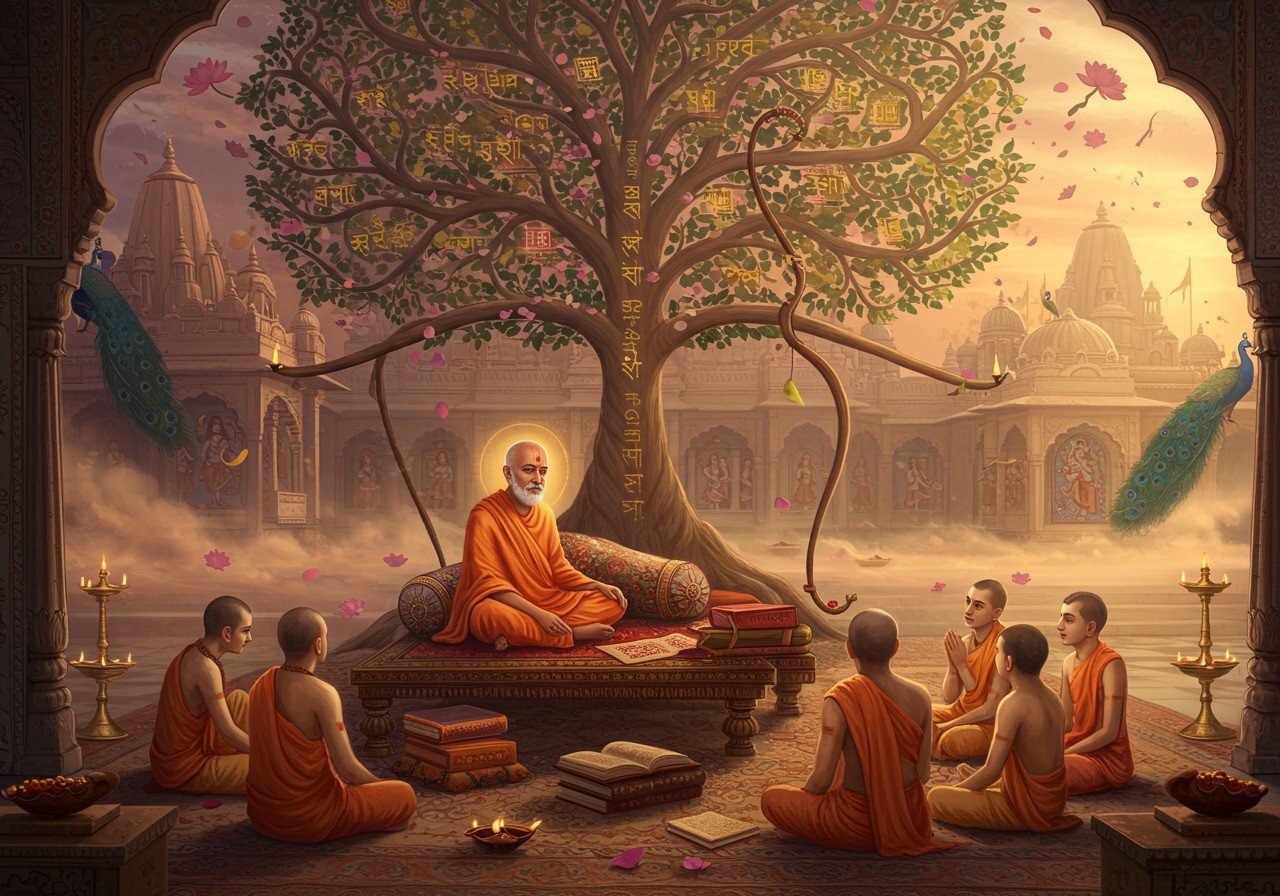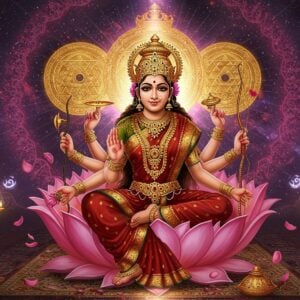
The Ramanandi tradition occupies a revered space in Hindu culture, deeply rooted in the Bhakti movement. It emphasizes a loving devotion to God, particularly through the veneration of Lord Rama. This exploration delves into the literary treasures, musical expressions, and unique ritual practices that characterize the Ramanandi Sampradaya.
Core Beliefs and Deities
At the core of the Ramanandi Sampradaya is the worship of Lord Rama as the supreme deity, alongside Sita, Lakshmana, and Hanuman. Rama and Sita are revered as the inseparable embodiment of the Supreme Absolute, eternally divine. The Sampradaya also emphasizes devotion to Lord Vishnu and his various incarnations, with a special focus on Rama.
Philosophical Foundation: Vishishtadvaita
The Ramanandi tradition’s philosophical underpinning is Vishishtadvaita, meaning “qualified non-dualism.” This profound philosophy views Narayana (Vishnu), individual souls (jivas), and the universe as distinct yet interconnected entities, forming a unified whole. This interconnectedness deepens the understanding of devotion and existence within the Ramanandi tradition.
Open Hearts and Open Doors: Inclusivity and Egalitarianism
A hallmark of the Ramanandi Sampradaya is its welcoming embrace of individuals from all walks of life. Transcending social barriers and caste distinctions, it fosters a spirit of unity and equality. This inclusive nature reflects the teachings of Ramananda, the founder of the movement in the 14th century, who championed egalitarianism.
Initiation and the “Ram Tarak Mantra”
Upon initiation into the Ramanandi Sampradaya, disciples receive the sacred “Ram Tarak Mantra” from their guru. This potent mantra serves as a spiritual tool, facilitating a deeper connection with the divine and guiding devotees on their spiritual path. It acts as a constant reminder of Rama’s presence.
Practices and Rituals: A Daily Connection
The Ramanandi Sampradaya is rich in practices and rituals that nurture a daily connection with the divine.
- Daily Chanting of Ram Naam: Chanting the divine name of Ram is central to Ramanandi devotion. This practice not only invokes a sense of the divine presence but also serves as a source of inner strength and peace throughout the day. It is a simple yet powerful way to connect with Rama.
- Guidance from Sacred Texts: Devotees draw wisdom and meaning from revered scriptures. These include the Valmiki Ramayana, Adhyatma Ramayana, Ramcharitmanas, Vedas, and Bhaktamal. These texts provide spiritual guidance and deepen the understanding of Ramanandi beliefs and practices. They offer a window into the rich philosophical and devotional world of the Sampradaya.
- Urdhva Pundra Tilak: The Urdhva Pundra, an upward-pointing tilak applied to the forehead, is a visible symbol of devotion and spiritual aspiration. This mark signifies allegiance to Lord Vishnu and his incarnations, particularly Rama. It serves as a constant reminder of one’s spiritual journey.
- Devotional Practices (Bhajans): Devotional songs, known as bhajans, are an integral part of Ramanandi worship. These soulful expressions of love and devotion are often accompanied by traditional instruments, creating an atmosphere of deep spiritual connection. Bhajans are a powerful way to experience the divine presence of Rama.
Festivals: Celebrations of Faith and Community
Festivals in the Ramanandi Sampradaya are vibrant expressions of faith, culture, and community bonding.
- Ram Navami: This joyous festival celebrates the birth of Lord Rama with readings from the Ramayana, devotional songs, and enactments of Rama’s life. It’s a time for families and communities to come together and rejoice in the divine incarnation of Rama. Special prasad and traditional dishes are often prepared and shared.
- Diwali: Diwali, the festival of lights, commemorates Lord Rama’s triumphant return to Ayodhya after his exile. Homes are illuminated with diyas (oil lamps), symbolizing the victory of good over evil. Families gather for festive meals and share sweets, celebrating the return of light and righteousness. Fireworks light up the sky, adding to the festive spirit.
- Holi: Although primarily associated with Radha and Krishna, Holi is also celebrated within the Ramanandi Sampradaya as a festival of divine love and the triumph of good over evil. The vibrant colors, music, and sweets add to the joyous atmosphere, creating a sense of unity and celebration.
Ascetic Traditions: The Sadhus
The Ramanandi Sampradaya includes ascetics known as sadhus, who dedicate their lives to the devotion of Rama. Through rigorous spiritual disciplines, they seek to attain liberation (moksha) or remain in a perpetual state of devotion. These sadhus are divided into three main groups: tyagis, rasiks, and nagas. Tyagis and nagas are known for their practice of physical austerities, while rasiks focus on the devotional worship of the deity’s image.
How Poojn.in Supports Your Ramanandi Practices
At poojn.in (https://www.poojn.in), we understand the importance of having authentic and readily available items for your Ramanandi rituals. We offer genuine Namavali/Ramavali (also known as Namabali or Ramabali), meticulously crafted from pure cotton thread in the traditional Bhagwa (saffron) color. These sacred threads are essential for various Ramanandi rituals and are available in both 66-inch and 33-inch lengths. You can find our XL Size Mayapuri Bhagwa Namavali with clear Hare Krishna prints in Bengali script, ideal for daily worship and havan ceremonies (https://www.poojn.in/product/11833/xl-size-mayapuri-bhagwa-namavali-namabali-ramabali-with-hare-krishna-printed-in-bengali).
We also offer a range of other essential puja items such as premium quality cotton Markin cloth in white (https://www.poojn.in/product/11826/premium-quality-original-coton-whie-markin-cloth-markin-cotton-unbleached-fabric-for-pooja-and-wearing) and red Shalu cloth (https://www.poojn.in/product/11782/premium-quality-original-coton-red-shalu-cloth-shalu-kapda-red-lal-cloth-puja-kapda-vastra-cloth-pack-of-1-100-natural-for-hawan-puja-pooja-cloth-aasan), ensuring you have everything you need for your spiritual practice. For temples, ashrams, and religious organizations, we offer convenient wholesale pricing options. Contact us at 03369029784 or WhatsApp 9476142738 for bulk orders and special pricing. We provide pan-India delivery, ensuring that you receive your items with ease and convenience.
Embracing the Ramanandi Tradition Today
The Ramanandi tradition offers a rich tapestry of devotion, philosophy, and community. With its emphasis on the worship of Lord Rama, it unites people from diverse backgrounds in a shared love and reverence. The teachings of Vishishtadvaita offer a profound understanding of the interconnectedness of all beings, while the daily practices keep followers anchored in their devotion. Through sacred texts, chants, rituals, and vibrant festivals, the Ramanandi Sampradaya continues to flourish, offering a path to spiritual growth and unity.
FAQs: Exploring Ramanandi Literature and Practices
What constitutes Ramanandi literature? Ramanandi literature encompasses a wide range of texts and scriptures connected to the teachings of Saint Ramananda, often delving into spiritual themes and practices observed by Ramanandi followers.
Where can one find Ramanandi books? Ramanandi books, offering invaluable insights into the tradition’s teachings and practices, can be found in numerous religious bookstores and online platforms. Poojn.in also provides a selection of relevant spiritual texts.
What exactly are Ramanandi bhajans? Ramanandi bhajans are devotional songs sung in praise of Lord Rama, playing a significant role in Ramanandi practices and fostering a deep sense of devotion and spiritual connection.
How are these bhajans typically performed? Ramanandi bhajans are traditionally performed with musical instruments such as the harmonium and tabla, often sung with heartfelt devotion within temples or during religious gatherings.
What is the Ramanandi puja paddhati? The Ramanandi puja paddhati refers to the specific set of rituals and practices followed by Ramanandi devotees during prayer and worship, incorporating specific chants, offerings, and daily routines.
Are there specific days designated for Ramanandi puja? Yes, specific days like Ram Navami and Diwali hold particular significance within the Ramanandi tradition, and devotees often perform special pujas on these occasions.
What motivates individuals to follow Ramanandi practices? People embrace Ramanandi practices to deepen their spiritual connection with Lord Rama and adhere to the teachings of Saint Ramananda, seeking a more fulfilling spiritual life.
Is the Ramanandi tradition open to everyone? Absolutely! Anyone with an interest in the teachings of Ramananda and devotion to Lord Rama is welcome to explore and follow Ramanandi literature and practices, regardless of their background. It’s a path open to all who seek spiritual growth.
Learn more about Ramayana festivals and their significance on our blog: https://www.poojn.in/post/14831/ramayana-festivals-celebrate-ancient-traditions-2. Explore deeper into the symbolism and teachings of the epic Ramayana: https://www.poojn.in/post/14827/symbolism-and-teachings-in-the-epic-ramayana-explained-2. Discover the profound influence of the Ramayana on Hindu spirituality: https://www.poojn.in/post/14951/ramayanas-influence-on-hindu-spirituality-2. Understand the valuable lessons on friendship, loyalty, and sacrifice from the Ramayana: https://www.poojn.in/post/14953/ramayana-friendship-lessons-loyalty-and-sacrifice-2.


